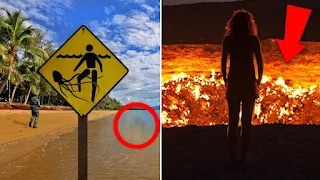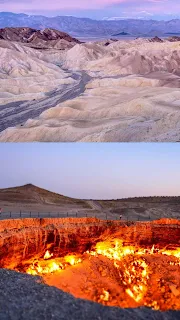The world is filled with fascinating yet dangerous locations that captivate adventurers, researchers, and thrill-seekers alike. These places stand out due to extreme natural conditions, political instability, or environmental hazards. Here’s an overview of the top 10 most dangerous places on Earth, highlighting their unique threats and challenges.
1. Death Valley, USA
- Location: California and Nevada, USA
- Danger: Extreme heat
- Why Dangerous: Death Valley is one of the hottest places on Earth, with record temperatures reaching 134°F (56.7°C). Its arid climate and lack of water make it extremely challenging for survival. Dehydration and heatstroke are serious risks for those who venture unprepared. Despite its harsh conditions, Death Valley's unique landscapes attract thousands of visitors annually.
2. Mount Everest, Nepal/Tibet
- Location: Himalayas
- Danger: Extreme altitude and unpredictable weather
- Why Dangerous: Climbing Mount Everest is a feat only a few achieve, but it comes with a high risk. The “death zone” above 8,000 meters is characterized by low oxygen levels, freezing temperatures, and violent storms. Avalanches and falling ice further endanger climbers. Every year, many lose their lives attempting to conquer the summit.
3. Snake Island, Brazil
- Location: Ilha da Queimada Grande, Brazil
- Danger: Venomous snakes
- Why Dangerous: This island is home to the golden lancehead viper, one of the deadliest snake species in the world. The density of snakes is alarming, with an estimated one snake per square meter. The Brazilian government prohibits visitors to protect both humans and the fragile ecosystem of this unique location.
4. Lake Natron, Tanzania
- Location: Northern Tanzania
- Danger: Caustic waters
- Why Dangerous: Lake Natron's water has a high concentration of alkaline salts, making it inhospitable for most life forms. Temperatures in the lake can reach up to 140°F (60°C), and the water's pH is nearly as caustic as ammonia. Birds and other animals that come into contact with the water often become calcified, earning the lake a reputation as one of the eeriest natural wonders.
5. Danakil Depression, Ethiopia
- Location: Afar Region, Ethiopia
- Danger: Extreme heat and toxic gases
- Why Dangerous: Known as one of the hottest places on Earth, the Danakil Depression experiences average temperatures of 94°F (34°C), with daytime highs often exceeding 120°F (49°C). The area is also filled with volcanic activity, sulfuric pools, and toxic gases that can be lethal. Its alien-like landscape is breathtaking yet treacherous.
6. North Sentinel Island, India
- Location: Andaman and Nicobar Islands, India
- Danger: Hostile indigenous tribe
- Why Dangerous: The Sentinelese people inhabit this remote island and are known for their isolation and hostility towards outsiders. Attempts to contact them have often ended violently, with the tribe attacking anyone who approaches. The Indian government has declared the island off-limits to protect both the tribe and outsiders.
7. Chernobyl Exclusion Zone, Ukraine
- Location: Pripyat, Ukraine
- Danger: Radiation
- Why Dangerous: The 1986 Chernobyl nuclear disaster released massive amounts of radioactive material into the environment. Though the Exclusion Zone has seen a resurgence of wildlife, radiation levels remain dangerously high in certain areas. Unauthorized exploration can result in severe radiation poisoning.
8. Oymyakon, Russia
- Location: Sakha Republic, Russia
- Danger: Extreme cold
- Why Dangerous: Oymyakon is the coldest inhabited place on Earth, with temperatures plunging to -90°F (-67.7°C). The frigid climate makes daily life a struggle for its residents. Visitors face challenges such as frostbite, hypothermia, and equipment failure due to the extreme cold.
9. Bermuda Triangle, Atlantic Ocean
- Location: Between Bermuda, Florida, and Puerto Rico
- Danger: Unexplained disappearances
- Why Dangerous: The Bermuda Triangle has long been associated with mysterious disappearances of ships and planes. While scientific explanations point to natural phenomena such as methane gas eruptions and unpredictable weather, its reputation for danger persists. Navigating these waters can be perilous due to sudden storms and strong ocean currents.
10. Mount Sinabung, Indonesia
- Location: Sumatra, Indonesia
- Danger: Active volcano
- Why Dangerous: Mount Sinabung is one of Indonesia's most active volcanoes, with frequent eruptions that devastate nearby villages. Volcanic ash, pyroclastic flows, and lava streams pose significant threats to life and property. The long-term effects of ash on agriculture and respiratory health make the region even more hazardous.
Conclusion
Each of these locations highlights the raw and untamed power of nature or the challenges posed by human and environmental factors. While they captivate with their beauty or mystery, they serve as a reminder of the risks inherent in exploring our planet's extremes. Whether through preparation or respect for boundaries, understanding these dangers ensures a safer appreciation of the world's most perilous places.


